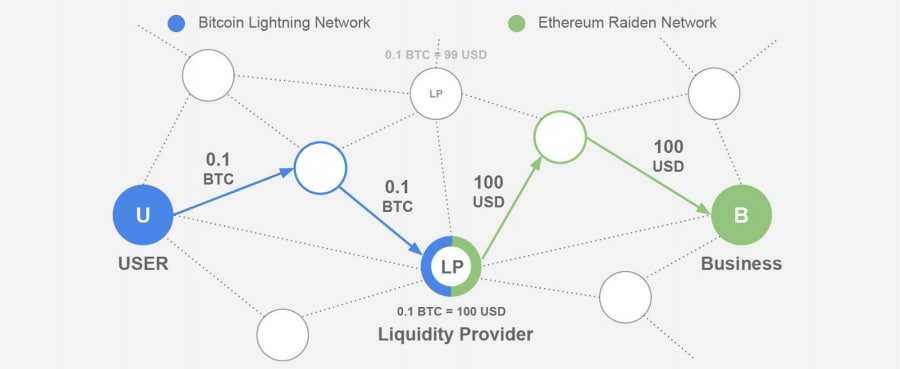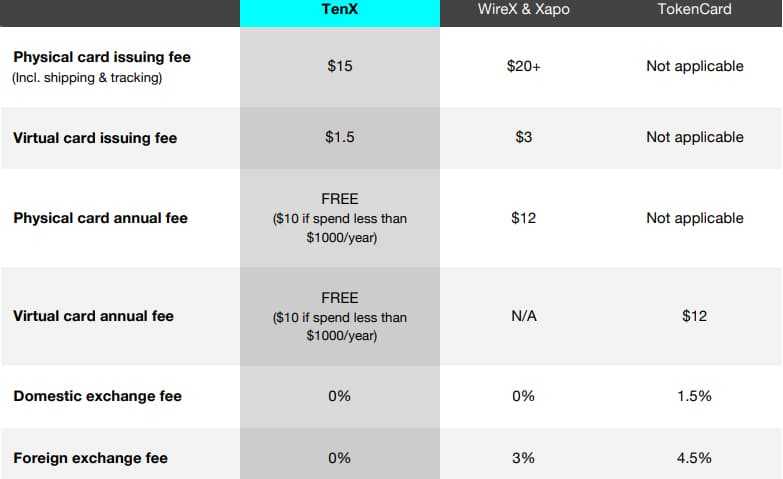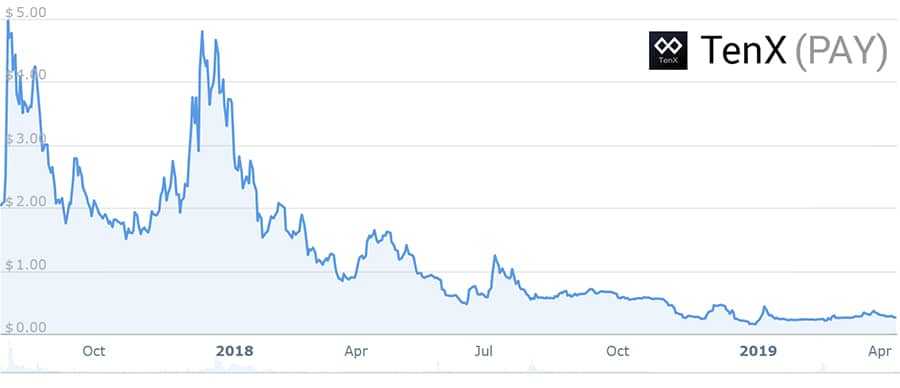TenX Review: The CryptoCurrency Backed Debit Card
TenX (PAY) is a cryptocurrency funded debit card that has had its fair share of ups and downs since its blockbuster ICO in 2017.
The vision behind TenX was to allow users to spend their crypto just as easily as they spent their fiat funds. Through the crypto backed cards, users could swipe away their coins for goods and services. However, since the launch there have been delays to the card roll out.
So, can TenX really deliver on their promises?
In this TenX review I will take an in-depth look at the project as well as its team, technology and roadmap. I will also analyse the long-term adoption potential of PAY tokens and whether they could ever recover.
What is TenX?
TenX isn’t a new project. It was launched back in 2015 and promised users a digital wallet and a physical debit card that would allow users to spend cryptocurrency on goods and services anywhere. The project has had a bumpy ride recently, with the initial release of the physical card being halted in early 2018 and the more recent card shipments being delayed as well.
The PAY token tied to TenX is an ERC-20 security token that acts as shares in the TenX company.
After missing initial shipment dates the TenX team took to Twitter on January 17 with a marketing video many called clever and some called distasteful, which assured users that cards were shipping in Singapore and later in the year would ship to APAC countries and Europe.
So the cards are finally out in Singapore, but is it too late for TenX? Because it’s hardly the only project looking to supply users with debit cards that allow them to easily tap cryptocurrency holdings.
Both Crypto.com (formerly Monaco) and Token are serious competition to TenX, with both working to push regulations that will allow a cryptocurrency payment card to be released for consumers.
It’s possible that those backers and early adopters who feel so scammed are gone for good, and TenX will be unable to pick up the pieces. Or maybe they will be able to forge ahead now that they’ve gotten back on track with card deliveries.
COMIT and TenX
TenX plans on delivering fee-free cryptocurrency exchange through its use of the Cryptographically-Secure Off-Chain Multi-Asset Instant Transaction (COMIT) network. While this network is separate from TenX, it is being developed by the same team.
COMIT will use a specialized routing protocol to enable seamless interoperability between blockchains, which will result in nearly free exchanges between them. COMIT cannot work with all blockchains, however, and is only compatible with those that have double spend protection and support hash functions, timelocks and multisig.

The COMIT network will function through Liquidity Providers who make the exchange verification process quick, simple and inexpensive. The TenX team has described it as a blockchain-based competitor for the SWIFT network.
In addition to supporting basic exchanges and purchase transactions, the TenX team plans on releasing a suite of developer tools that will support the creation and use of other financial products with TenX, such as loans and ETFs. Eventually, TenX envisions its network providing for every facet of consumer finance and payment processing.
While a demo of a swap between PAY and BTC using COMIT has been completed the mainnet COMIT hasn’t been released yet, and the team admits it remains highly experimental at this time.
There are also questions of whether COMIT will rely on the Ethereum blockchain or a native blockchain once the mainnet launches. Running and maintaining a platform of this scope is both difficult and expensive, and there is no certainty the COMIT team can pull it off.
TenX Card Fees
While there are no fees for using the TenX card, there are fees for acquiring it. That’s how TenX plans on funding their project.
The way the structure is currently designed users would pay $1.50 to use the TenX card digitally, or $15 to obtain a physical card. There is no annual fee for using the card, as long as you spend a minimum of $1,000 a year. If you don’t meet that minimum threshold the TenX card has a $10 annual fee.
In the original whitepaper, there was also a rewards program linked to the TenX card and PAY token. Basically, you earned rewards by holding PAY tokens and by using the TenX card.

In that original whitepaper holders of PAY, tokens would receive 0.5% of all the aggregate monthly transaction volume on the network. These payments would be made in Ethereum and would grow along with network usage. Ultimately the whitepaper envisioned the network growing large enough that payments would be made hourly.
In addition, the whitepaper outlined a reward scheme for card users where they would receive a 0.1% reward in the form of PAY tokens each time they used their TenX card.
Unfortunately, these rewards programs were never implemented and as of October 2018, both have been removed, with the team stating that they were rethinking the rewards program.
At this time there is no rewards program, and there are a number of early adopters who are quite upset with the project because their initial buy of PAY tokens was with the understanding they would receive rewards in line with the program talked about in the original TenX whitepaper.
The TenX Platform
While COMIT might not be ready yet, the platform comes with a strong toolset and controls for users.
Users are able to prevent unauthorized card usage by setting limits on spending, withdrawals, and purchases and these can be daily limits or overall limits. This is all done using Decentralized Security Smart Contracts.

Of course, the biggest benefit for users is that they can spend cryptocurrencies at any retailer who accepts Visa cards. There’s no longer a need to confine yourself only to merchants who accept cryptocurrency.
All of this is done through a financial intermediary who holds the deposited cryptocurrency in escrow and makes payments to merchants in fiat. The lender then settles the account based on the exchange rate in effect when the transaction occurred. The merchant gets paid immediately, but it can take several days to settle the exchange transactions on the backend.
Previously WaveCrest was backing the TenX card, but there’s been no announcement who is backing the cards that are currently being shipped in the APAC region. There were also indications that TenX was trying to get a banking license themselves to become the financial backer. If this is what happened it’s somewhat troubling as it makes TenX more centralized.
TenX Crypto Wallet
TenX has also developed their mobile wallet which will work in conjunction with their crypto card. This can be used like any other crypto mobile wallet and currently supports Bitcoin (BTC), Ethereum and Litecoin.
This App will be paired with the card so that users can spend their crypto for in-store purchases, online shopping or even to withdraw cash from an ATM. You can also control the card from the app in the event that it is lost by disabling the chip.
Safety Tip?: The moment that you have downloaded the App, be sure to enable two factor authentication
The TenX App was released not long after the ICO back in November of 2017 and has been evolving since then. It is currently available in both iOS and Android. If we take a look into the respective app stores we can see the reviews which are quite polarised.

However, if one was to take a deeper look into the reviews, most of the comments appear to be frustrations with the shipping delay of the cards. While these are reasonable, they are not really related to the functionality of the App or wallet.
What is encouraging though is the fact the TenX developers are following up to these complaints and reviews. This shows that they are receptive to the criticisms of the community and are keeping them well informed.
There have been plans to add additional cryptocurrencies to the App although the team is perhaps preoccupied with the release of the cards recently.
TenX Team
The TenX team is based in Singapore and is currently run by co-founder and CEO Toby Hoenisch. Prior to founding TenX Toby was the co-founder and CEO of a software development company called One One Agency which was involved in creating integrated payment systems for private clients.

A second co-founder is Michael Sperk, who serves as head of engineering at TenX. He gained his engineering and technical experience working as a technical lead at Visualyze, where he helped develop a browser-based tool that performed visual analysis on social media messages and was capable of processing hundreds of thousands of messages in real-time.
The third co-founder is Paul Kittiwongsunthorn who worked alongside Toby at the One One Agency and serves as the Chief Development Officer at TenX.
There was a fourth founding member of the team, however, he is no longer listed as a founder on the TenX website due to some controversy surrounding his past activities, specifically his connection with a ponzi scheme from 2011 through 2015. That fourth member is Julian Hosp and he stepped down as president of TenX on January 8, 2019.
The PAY Token
TenX uses the PAY token as a security token for its network and the ICO held on June 24, 2017, was huge, to say the least. The project raised $80 million in just one day, selling PAY tokens for $0.8701 each. The price began to rally in August 2017 and reached an all-time high of $6.21 on August 12, 2017.
That’s unique among cryptocurrencies as most reached their all-time highs in January 2018 following the huge December 2017 run-up in Bitcoin. The price pulled back from that high, but rallied to over $5 once again in January 2018 before sinking alongside the rest of the cryptocurreny market throughout 2018.

There is no mining of PAY as the entire supply was pre-mined. The total supply is 205,218,256 PAY and the current circulating supply is 114,347,861 PAY. The project expects to release about 55 million PAY tokens in the next 4 years as part of a community and business development fund, while the remaining tokens will be split between the TenX company and the founders.
The PAY token is available on a number of exchanges, but the notable missing exchange is Binance. The top exchanges by volume for PAY are Dcoin and Bithumb. There’s also a good amount of volume on OKEx. Other choices would be Bittrex, Upbit, Huobi Global and Gate.io among a handful of others.
There appears to be reasonable liquidity for the token split across all of these exchanges. Of course, the bulk of the volume is done in two Asian exchanges which means that PAY is quite susceptible to news flow out of the region (particularly South Korea). Hence, PAY is generally more volatile than comparable tokens.
If you have purchased PAY tokens, best practice is to store it off the exchange in a wallet. Since PAY is an ERC-20 token it can be held in any ERC-20 compatible wallet such as MyCrypto or MyEtherWallet.
Conclusion
TenX began with huge ambitions and if it had been able to remain on track it might now be the clear leader in making cryptocurrencies easy to spend.
However, the setbacks experienced by the team have put TenX in a position where it is on even footing or perhaps even playing catch-up with similar projects. The coming year should tell whether it is able to secure dominance or not.
Success will depend on how quickly they can expand the footprint of their cards, the addition of new cryptocurrencies to the ecosystem, and the addition of a rewards system, which is what attracted many early investors.
It’s also critical that COMIT launches on a mainnet to keep costs and fees down.
Even with all these things in place, it’s unclear if the cryptocurrency community will excuse the mistakes made by TenX and accept them as a viable project again. Looking at the struggle PAY is experiencing in recovering the future success of the project remains questionable.
Disclaimer: These are the writer's opinions and should not be considered investment advice. Readers should do their own research.
Disclaimer: These are the writer’s opinions and should not be considered investment advice. Readers should do their own research.
